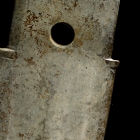J.J. Lally & Co., Oriental Art / New York City, New York
MenuPast Exhibition
Ancient Chinese Jade
March 15-29, 2018
56.
AN ARCHAIC JADE CEREMONIAL JADE DAGGER-AXE (GE)
Early Shang Dynasty, circa 15th Century B.C.
the sturdy blade with straight cutting edge on one side opposite a gently curving edge, beveled on both sides of both edges, the short sharp point set slightly askew with a shallow medial ridge rising from the point and dissolving into the flat center of the blade, pierced with a central aperture at the base of the squared tang marked by a pair of small teeth projecting at either side, the butt end left rough on one side, the grayish green stone with darker mottling.
Length 11 1⁄4 inches (28.5 cm)
Compare the similar Shang dynasty jade ge unearthed from the Eastern Zhou cemetery at Liangdaicun, Hancheng, Shaanxi province, illustrated in Yuhui Jinsha: Xia Shang shiqi yu wenhua tezhan (A Convergence of Jade at Jinsha: Special Exhibition of the Jade Culture of the Xia and Shang Periods), Chengdu, 2017, p. 89. Another similar Shang dynasty jade ge excavated from ritual pit no. 2 at Sanxingdui, Guanghan, Sichuan province, is illustrated by Gu (ed.), Zhongguo chutu yuqi quanji (Complete Collection of Jades Unearthed in China), Vol. 13, Sichuan, Chongqing, Beijing, 2005, p. 33.
Shang jade dagger-axes were made for ceremonial use, but in form they were modelled after functional bronze weapons. For a comprehensive discussion of this form of jade blade as it evolved throughout the Shang dynasty, see Wilson, “Lithic Art in the Bronze Age: A Jade Dagger-Axe,” The Bulletin of the Cleveland Museum of Art, January 1990, vol. 77, no. 1, where the author illustrates on p. 12 fig. 15 a bronze dagger-axe of closely related form, unearthed at Xinzheng, Henan province, described as Erligang period.
商早期 玉戈 長28.5厘米
